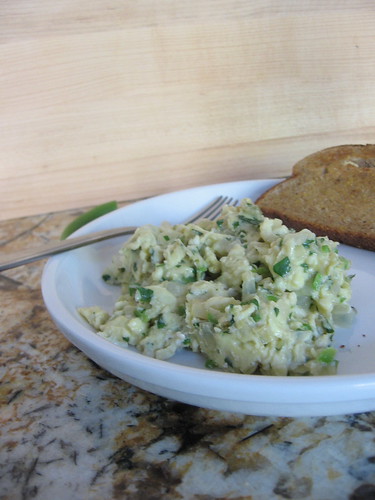However, when I saw a recipe for cold noodles with sesame sauce, I couldn't help myself. I just so happened to have some prawns in the fridge and a bag of green beans that needed to be used. I seem to be having a real love affair with sesame seeds these days, and who can blame me? The dry nuttiness is well suited to most vegetables, and when mixed with the salty-sour-sweet ingredients and a big pile of cold noodles, it makes the perfect summer meal.


Despite a few foibles, like forgetting to allow time to let the meal be well chilled—resulting in a colander full of pasta and ice cubes—and adding a bit too much water to the sauce, this meal was fast and easy. My beloved blender recently broke, so I used an immersion blender for the sauce; the resulting mixture was not perfectly smooth, but had lots of whole sesame seeds studded throughout.
Cold Sesame Noodles with Green Beans
Adapted from a recipe at Dispatches from Whitcomb Street
For the sauce (have more of the first four ingredients to adjust flavors):
2 tablespoons good soy sauce
2 tablespoons rice wine vinegar
2 tablespoons mirin
1 tablespoon sugar
a small lump of ginger, peeled and coarsely chopped (about 1 tablespoon)
1 clove garlic
2 tablespoons sesame seeds.
For the noodles:
12 ounces green beans
8 ounces wide Asian wheat noodles
¼ small sweet or red onion
2 small carrots
6-8 ounces peeled prawns, preferably butterflied
2-3 tablespoons cilantro, plus additional for garnish
Place the sauce ingredients in a medium bowl and blend with an immersion blender until well blended but with plenty of whole seeds—use a stand blender if you prefer a smoother sauce. Taste the sauce and adjust to your desire; I added a bit more mirin and soy sauce. Thin the sauce a bit with 1-2 tablespoons water; set aside in the fridge.
Bring a big pot of salted water to boil; meanwhile, snap the ends of the green beans and break them into 2 inch pieces. Boil the green beans just until tender, 4-6 minutes. Fish the beans out and transfer to a large bowl of cold water.
Return the pot of water to the boil, add the noodles, and cook until a bit shy of al dente, probably 4-6 minutes. Meanwhile, sliver the onion and julienne the carrots. Drain the green beans and add the other vegetables to the bowl.
Toss the prawns into the pasta water for the last 1 minute of cooking; when the prawns are opaque throughout and the noodles are al dente, drain the works and rinse well in cold water. When cooled, add to the vegetables and pour about half the sauce over. Toss until the noodles are completely coated in sauce; chill until cold.
Before serving, chop the cilantro and mix it in, adding additional sauce as desired. Serve cold.
Serves 4







